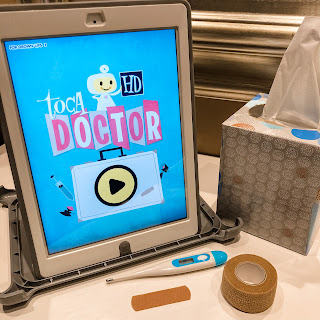Toca Boo
The power is out at Bonnie's house due to a terrible storm. Help her move through the house and scare her family! Explore different rooms, turn sinks and lights on and off to build suspense and even stop to snack on plums, spicy pepper and soda to fuel your fun!-Map skills
-Following directions
-WH questions
-Oral motor practice (pa/pop, ma/mom/mama, boo, pop up, toot, go, baby, down, in, behind, under, Bonnie, sisters, brother, grandma, grandpa)
Toca Kitchen 2
Cook up some fun in your speech sessions with this app. Help feed the hungry customers by preparing different foods.-Following Directions
-Make sentences
-Pronouns
-Commenting Like/Dislike
-Oral Motor words/phrases to use (ah/mmm, uh-oh, ya/yes, no, hot, pot, pan, not, can, eat, gone, make, done, eat it, can cut it, can eat it)
*My students enjoy using the hard print items and Boomcard companions I made for this app*
Pet Doctor
Take care of all the pets in the office, feed them and put them to bed.-Discuss cause/effect
-Identify body parts/injuries/doctor equipment
-Commenting
-Oral Motor practice (oh no/uh oh, boo-boo, go home, eat it, put it on)
Pair the app with a simple matching activity (I found this one years ago at the Target dollar spot) or Henning Lohlein's "All Better Book".
I incorporate additional fine motor skill work by playing "save the animals", where they are trapped in rubber bands.
-Take the rubber bands off
-Clean the animals with a spray bottle
-Place tape or real band-aides on the injury
Toca Doctor
Help the patient with all their injuries.Toca Store
Open the store and choose the items you want to sell. Students can take turns being the cashier and the customer.Describe categories & functions of items
Expand vocabulary
Social communication/turn taking
Oral Motor practice (I want, I choose, put it in, need it)
Zoombinis
Use logic, analyze data, spot patterns and hone problem-solving skills with 12 perilous puzzles and four levels of difficulty. Great for upper elementary, middle school and high school students.
-Intro video (wh questions, story comprehension)
-Problem solving
-Teamwork
-Identify details
-Follow directions
-Express ideas
*For iPad only, you won't be able to find it if you search on your phone*


















